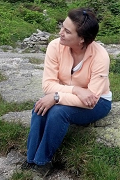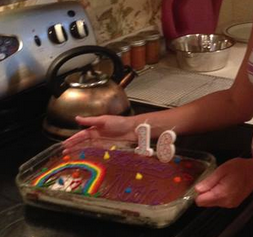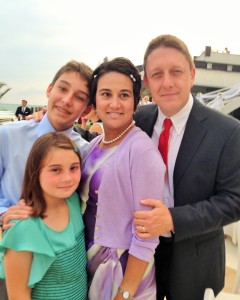 Here on this website, we’ve been writing personal appeals in the hope that you’ll help Tracy Jalbuena find a bone marrow donor who is a match with her human leukocyte antigen (HLA) type. Someone willing to donate bone marrow stem cells could save her life and cure her deadly multiple myeloma.
Here on this website, we’ve been writing personal appeals in the hope that you’ll help Tracy Jalbuena find a bone marrow donor who is a match with her human leukocyte antigen (HLA) type. Someone willing to donate bone marrow stem cells could save her life and cure her deadly multiple myeloma.
I know Tracy as my spouse. She’s the love of my life. I know you’d love her if you met her. She’s a life worth saving. That’s what drives me to write this appeal.
But what if you don’t know Tracy? Why should you bother joining the National Bone Marrow Registry if you don’t care two hoots about this somebody named Tracy Jalbuena? There’s a good reason. Just look around you and do the math.
According to the National Cancer Institute, 0.7% of people will be diagnosed with the deadly blood cancer multiple myeloma at some point in their lives. 0.7% may not sound like much, but let’s put that in perspective relative to the population of the United States, the country where Tracy lives. As of December 2014, the U.S. population stands at 320,000,000 people. 0.7% of that many people is 2,240,000 people. At some point in their lives, 2.24 million Americans alive today will be diagnosed with multiple myeloma. That’s a lot of people with multiple myeloma, a disease for which the only possible cure is an allogeneic transplant of bone marrow stem cells.
So what? Well, first of all, maybe that person in need will turn out to be you. By encouraging the people around you to sign up for the National Bone Marrow Registry, you could save your own life at some point in the future.
But of course this isn’t just about you, just as it isn’t just about Tracy. Think about all of the people you know. Social scientists have figured out through repeated research that the average person is acquainted with 290 other people. These are people who you can recognize by sight or name and who you know how to get in touch with.
Imagine those people and ask yourself:
If you could save the life of one of these people you know, would you do it?
What if it were easy to save that person’s life?
What if it didn’t cost you a penny?
This is not a hypothetical question. Just do the math. Of all people alive today, 0.7% will be diagnosed wth multiple myeloma and face the need for the only cure they can get. 0.7% of 290 people is 2.03. The chances are that two people you know by face or name today have developed or will develop multiple myeloma.
And that’s just the numbers for multiple myeloma. Did you know that bone marrow stem cell donation saves the lives of people with many more diseases? They include:
| Chronic lymphocytic leukemia (CLL) |
| Chronic myelogenous leukemia (CML) |
| Hodgkin lymphoma |
| Hurler syndrome |
| Krabbe disease (Globoid-Cell Leukodystrophy) |
| Metachromatic Leukodystrophy (MLD) |
| Myelodysplastic syndromes (MDS) |
| Non-Hodgkin lymphoma (NHL) |
| Severe aplastic anemia |
| Severe Combined Immunodeficiency (SCID) |
| Sickle cell disease (SCD) |
| Wiskott-Aldrich syndrome (WAS) |
People suffering from these diseases are everywhere. Chances are, you know more than one person who will be hit by one of them. And you can save their lives.
Why wait? It’s easy — just fill out a request at bethematch.org and get a free cheek swab kit in the mail. Sending a sample back in is incredibly simple and painless — you just rub four cheek swabs on the inside of your cheek and put those swabs back in the mail.
Getting tested doesn’t cost you a dime if you’re in the prime target range of 18-44 years of age for health bone marrow. The National Bone Marrow Registry picks up the expense.
Donating bone marrow stem cells doesn’t cost you a dime either. If you end up being a match, the National Bone Marrow Registry and the health insurance company of the person who needs a transplant will pick up travel costs, lodging costs and medical costs associated with the transplant.
You could be a hero, and not just for someone like Tracy Jalbuena who you don’t know. Look around you now. Think about those you know and love.
Now stop thinking and do something about it. Take five minutes to join the National Bone Marrow Registry. You have my deep, personal thanks right now. You might be surprised at who will thank you in the future.

 A pause. A mutual glimpse. Understanding. Then she nodded as I said the words, “you might not be here for his next cake.”
A pause. A mutual glimpse. Understanding. Then she nodded as I said the words, “you might not be here for his next cake.” Here on this website, we’ve been writing personal appeals in the hope that you’ll help Tracy Jalbuena
Here on this website, we’ve been writing personal appeals in the hope that you’ll help Tracy Jalbuena 